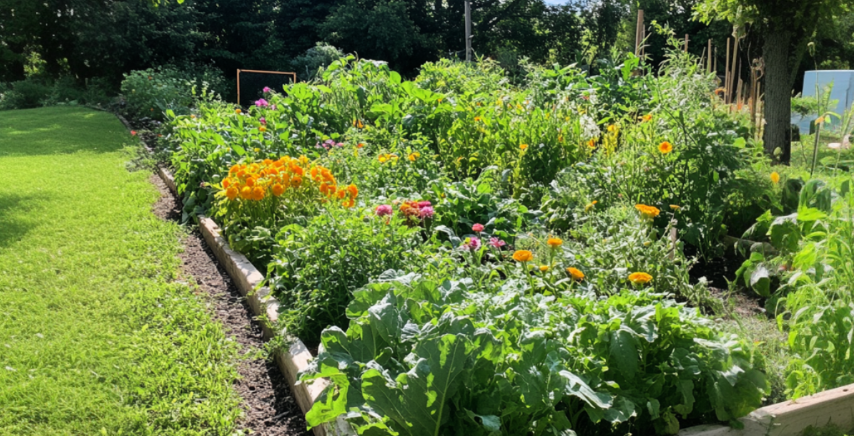Have you ever wondered why some gardens flourish effortlessly while others seem to struggle? The secret might be in the company they keep. Companion planting, an age-old gardening technique, involves growing certain plants together, boosting their growth and overall health. Imagine a garden where tomatoes thrive beside basil or where marigolds shield your veggies from pests. Intrigued? Then let’s dive into the magic of companion planting!
The Basics of Companion Planting
Companion planting offers many benefits that go beyond mere aesthetics. In fact, it not only improves soil fertility but also repels pests and enhances the overall health of your garden. Here are seven exciting reasons why you should embrace companion planting in your garden.
Boosted Growth and Yield
One of the biggest advantages of companion planting is boosted growth and higher yields. Certain plant combinations naturally improve each other’s growth by providing essential nutrients, enhancing soil structure, or offering shade. For instance, beans fix nitrogen in the soil, benefiting heavy-feeding plants like corn and tomatoes. Therefore, strategically pairing plants can create a more productive garden. According to Gardener’s Supply Company, strategic plant pairings can lead to significant growth improvements.
Natural Pest Control
Companion planting is also great for natural pest control. Some plants have strong scents that deter pests, while others attract beneficial insects that prey on garden pests. For example, marigolds release a scent that repels nematodes and harmful insects. Meanwhile, dill and fennel attract insects like ladybugs and hoverflies that eat aphids. Thus, integrating these plants reduces the need for chemical pesticides, promoting a healthier ecosystem. The University of California Integrated Pest Management program provides extensive resources on natural pest control methods.
Improved Soil Health
Healthy soil forms the foundation of a thriving garden. Companion planting plays a crucial role in maintaining soil health. Different plants have varying nutrient needs and root structures, which helps prevent soil depletion and erosion. For instance, deep-rooted plants like carrots break up compacted soil, while legumes such as peas and beans enrich the soil with nitrogen. Therefore, rotating and interplanting these crops maintains soil fertility and creates a robust environment for future plantings. For more information on soil health, visit the Natural Resources Conservation Service.
Efficient Use of Space
Companion planting also lets you make the most of your available space by utilizing the natural growth habits of different plants. For example, tall, sun-loving plants provide shade for shorter, shade-tolerant plants, creating a more diverse and productive garden. For instance, growing lettuce beneath taller crops like tomatoes or corn protects the greens from the intense summer sun. Consequently, this vertical layering maximizes space in small gardens and boosts productivity. The Old Farmer’s Almanac offers additional insights on efficient garden planning.
Weed Suppression
Weeds compete with garden plants for nutrients, water, and sunlight. Companion planting helps suppress weeds by creating dense plantings that shade the soil and inhibit weed growth. Ground-cover plants like clover and creeping thyme spread quickly, covering bare soil and making it hard for weeds to establish. Additionally, some plants release chemicals that inhibit the growth of nearby weeds, reducing competition and promoting healthier crops. For more on weed suppression, check out the resources from Rodale Institute.
Enhanced Flavor and Aroma
Interestingly, companion planting can also enhance the flavor and aroma of fruits and vegetables. Aromatic herbs like basil, dill, and mint improve the taste of neighboring plants by releasing beneficial oils and attracting pollinators. For instance, basil enhances the flavor of tomatoes when planted nearby, creating a harmonious combination that delights the senses. Moreover, these beneficial interactions lead to more flavorful and aromatic harvests. The Herb Society of America provides detailed information on using herbs in companion planting.
Biodiversity and Ecosystem Health
Promoting biodiversity in your garden through companion planting supports a healthy ecosystem. Diverse plantings attract beneficial insects, birds, and other wildlife, creating a balanced and thriving environment. Moreover, diversity helps control pest populations, improve pollination, and reduce disease outbreaks. Therefore, a biodiverse garden is more resilient to environmental stresses, better withstanding climate change challenges, and ensures long-term productivity. For more tips on promoting biodiversity, visit the Royal Horticultural Society.
Practical Tips for Successful Companion Planting
To make the most of companion planting, consider these practical tips:
- Plan Ahead: First, research compatible plant pairings and plan your garden layout accordingly. Keep a record of successful combinations and any challenges you encounter.
- Diverse Plantings: To further promote biodiversity in your garden, be sure to include a variety of plants. This not only creates a balanced ecosystem but also supports various beneficial organisms.
- Rotate Crops: Additionally, practice crop rotation to prevent soil depletion and reduce the risk of pests and diseases.
- Interplanting: Use interplanting techniques to maximize space and create beneficial plant interactions. For example, alternate rows of heavy feeders with nitrogen-fixing plants to maintain soil health.
- Observe and Adapt: Finally, monitor your garden regularly and adapt your planting strategies based on your plants’ needs and any emerging challenges.
Ready to Transform Your Garden?
Incorporating companion planting into your gardening routine leads to healthier plants and higher yields and creates a more sustainable and enjoyable gardening experience. By understanding and leveraging the natural relationships between plants, you can create a thriving garden that supports itself and the surrounding ecosystem. Therefore, embrace the wisdom of companion planting and watch your garden flourish!
For more detailed tips and tricks, visit Gardeners’ World and the Royal Horticultural Society. Additionally, check out our full guide on companion planting strategies to take your garden to the next level!



